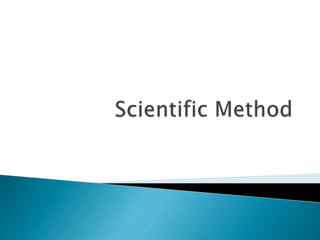
Power point scientific method (1)
- 2. Helps us to answer questions Gives logical steps Requires supporting evidence Others are able to repeat and critique your experiment
- 3. Problem/Purpose (ask a question) Research/Gather Information Construct a Hypothesis Test with an Experiment Analyze Data/Results Conclusion
- 4. No it varies depending on the question being asked but it generally follows the same guidelines.
- 5. Reason for doing the experiment ◦ Why is the sky blue ◦ Why do solid ice cubes float in water ◦ To determine if plants grow better in artificial light or natural light ◦ To determine if studying will increase test scores
- 6. Gather information about the topic through your five senses and other sources ◦ The sky is blue but sometimes it’s gray ◦ Ice cubes are forms of solid water, they are cold and at times very light ◦ Artificial light can come in a variety of intensities 60w 75w 100w etc.
- 7. An educated prediction of the outcome ◦ The sky is blue because it reflects the ocean ◦ The sky is blue because martians color it with blue crayons at night Opinionated statements are not testable ◦ Kevin Durant is the best BB player hands down! We will use the “If”, “Then” format ◦ If I study all week long, then my test grade will improve.
- 8. A well written hypothesis consists of an “if” statement and a “then” statement. The “if” statement contains information on what your are testing, and the “then” statement reflects your beliefs of the outcome of the experiment.
- 9. “If we change the size of a hole in the bottom of a funnel, then the funnel will sink at a faster rate” “If caffeine is increased in someone’s body, then their reaction time will be quicker”
- 10. Steps developed to test your hypothesis ◦ Have two students of equal academic standing take the same test ◦ Allow one student to study without allowing the other student to study ◦ Compare the results
- 11. A procedure is a list of steps that a scientist takes to complete the experiment. This is a very detailed list that is numbered in 1,2,3..... order. It is not a paragraph! It may include drawings. You know you have written a good procedure when someone can read it and do the experiment exactly like you did.
- 12. 1. Fill a clear, 4 liter bucket to 1 inch from the top 2. Place funnel on the top of the water with the hole facing down 3. Let funnel sink and record the time it takes to hit the bottom 4. Record this time in a data table 5. Take the funnel out of the water and place one, 3/4 inch brass washer inside the funnel. 6. Repeat steps 2 through 4. 7. Repeat step 5 by adding two, 3/4 inch brass washers inside the funnel. 8. Repeat steps 2 through 4 9. Repeat step 5 by adding three, 3/4 inch brass washers inside the funnel. 10. Using your data table, make a line graph representing the sinking times of all three funnels.
- 13. All measurements in an investigation need to be recorded in a data table. The table must have a title (related to what you are measuring), and appropriate labels for the rows and columns.
- 14. Examine information collected during your experiment Restate data collected Student A received a 95% and a 90% Student B received a 72% and a 75% Tests Taken Student A Studying Student B w/o Studying Trial 1 95% 72% Trial 2 90% 75%
- 15. In order to understand and interpret your data, you need to make a graph. A graph lets you see trends in the data and it also helps you look at the data in a way that is easy to understand. Insure that all of your labels and increments are correct! A graph must have a title, X and Y axis's labeled (Independent and dependent)
- 16. A handy way to remember what a graph needs is through the acronym TAILS TITLE AXIS INTERVAL LABELS SCALE
- 17. Statement of rather your hypothesis was correct or incorrect based on your results ◦ My hypothesis was correct studying increases test scores. Description of any errors/mistakes that occurred Suggestions to improve your experiment Share information learned for other scientists
- 19. Number your paper 1-10 and answer the following questions in your notebooks Include only the number and the answer
- 20. 1. The first step in the scientific method is: A. conducting an investigation B. writing a testable question C. writing a hypothesis D. drawing conclusions
- 21. 2. Opinion questions are: A. testable B.not testable C.scientific
- 22. 3. An educated guess about the outcome of the investigation is called a: A. guess B.hippopotamus C.hypothesis D. hyperbole
- 23. 4. When writing a procedure, it should contain lots of: A. words B. paper C. details
- 24. 5. You can remember what a graph needs by the acronym________________
- 25. 6. A data table must also have a ________ at the top and the ______ and ________ must be labeled too.
- 26. 7. A ________ helps you look at data in a way that is easy to understand. It shows trends.
- 27. 8. What does dependent variable mean?
- 28. 9. It is very important to place a _______ on the top of your graph
- 29. 10. To make our experiment complete, we must _______ our findings with other people.
